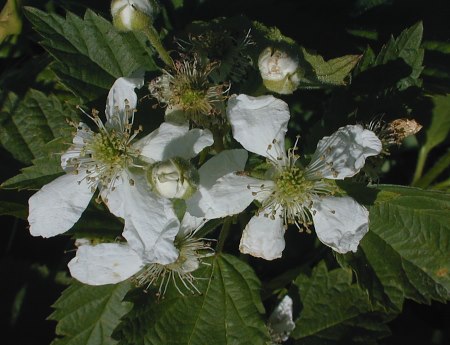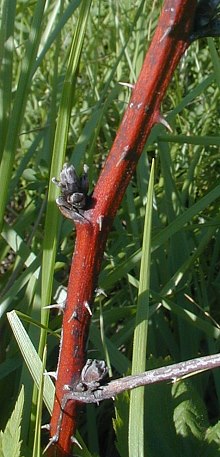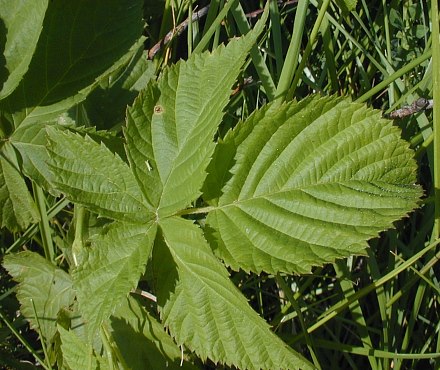Description: This perennial shrub is 2-5' tall, forming arching woody canes. First-year canes produce leaves that are palmately compound (usually 5 leaflets), while second-year canes produce trifoliate leaves (3 leaflets). First-year canes are infertile, while second-year canes bear flowers and fruit. The latter die down after bearing fruit, but they often start new canes vegetatively when their tips touch the ground. Young canes are light green, stout, and rather angular, but they later become red, reddish brown, or black. Stout prickles occur along the sides of the canes; these prickles are usually curved, rather than straight.

The compound
leaves of first-year canes span up to 6" long and 6" across (excluding
their petioles). The terminal leaflet is larger than the lateral
leaflets; it is up to 3" long and 2½" across (less than twice as long
as its width). Each terminal leaflet is ovate to oval in shape, rounded
or cordate at the base, and coarsely serrated along its margins; the
lateral leaflets are similar, except they are more slender in shape. At
the base of each terminal leaflet, there is a conspicuous basal
stalklet (petiolule) about ½" long, while the lateral leaflets are
sessile, or nearly so. On the upper surface, each leaflet is medium
green and either hairless or sparsely hairy; on the lower surface, each
leaflet is light green and finely pubescent, especially along the
veins. The petioles of the compound leaves are up to 4" long, pale
green, and either hairless or sparsely pubescent; there are often 1-2
tiny curved prickles along the length of each petiole. The leaflets of
second-year canes are slightly smaller in size than those of the
first-year canes, and their terminal leaflets are more slender than the
terminal leaflets of the latter. Otherwise, the leaflets of both types
of canes are very similar to each other. Second-year canes bear short
corymbs of flowers spanning about 2-4" across. Each flower is about 1"
across, consisting of 5 white petals, 5 light green sepals, a cluster
of light green pistils, and numerous
stamens. The petals are oblanceolate in shape and rather wrinkled in
appearance; they are much longer than the slightly pubescent sepals. At
the base of the pedicel of each flower, there is either a stipule-like
or leafy bract of varying size; the flowers are often partially
hidden by these bracts. The blooming period of this blackberry occurs
during late spring to early summer, lasting about 3 weeks. The flowers
are replaced by a juicy fruits (compound drupes) that are globoid-ovoid
in shape and up to ¾" long. The fruits become black at maturity during
mid- to late summer; they have a pleasant sweet-tart flavor, sometimes
with a slightly bitter aftertaste. Each drupelet within a fruit
contains a single seed. The root system is woody and branching. Loose
colonies of plants are often formed from vegetative propagation of the
canes.
of both types
of canes are very similar to each other. Second-year canes bear short
corymbs of flowers spanning about 2-4" across. Each flower is about 1"
across, consisting of 5 white petals, 5 light green sepals, a cluster
of light green pistils, and numerous
stamens. The petals are oblanceolate in shape and rather wrinkled in
appearance; they are much longer than the slightly pubescent sepals. At
the base of the pedicel of each flower, there is either a stipule-like
or leafy bract of varying size; the flowers are often partially
hidden by these bracts. The blooming period of this blackberry occurs
during late spring to early summer, lasting about 3 weeks. The flowers
are replaced by a juicy fruits (compound drupes) that are globoid-ovoid
in shape and up to ¾" long. The fruits become black at maturity during
mid- to late summer; they have a pleasant sweet-tart flavor, sometimes
with a slightly bitter aftertaste. Each drupelet within a fruit
contains a single seed. The root system is woody and branching. Loose
colonies of plants are often formed from vegetative propagation of the
canes.
Cultivation:
The preference is full or partial sun, moist to dry-mesic conditions,
and soil containing loam, clay-loam, or some rocky material. The size
of the fruit is strongly influenced by the amount of precipitation
during the first half of summer.
Range & Habitat:
The native Pennsylvania Blackberry is fairly common and it can be found
throughout Illinois (see Distribution
Map). Habitats include woodland openings, woodland edges,
savannas, thickets, weedy meadows, and fence rows. This shrub is
typically found in areas with a history of disturbance, although it is
intolerant of regular mowing.
Faunal Associations:
This species and other blackberries (Rubus spp.)
are
important to many kinds of wildlife. The nectar and pollen of the
flowers attract many kinds of insects, including long-tongued and
short-tongued bees, wasps, bee flies, butterflies, and skippers. Other
insects feed destructively on the foliage, canes, and other parts of
blackberries. These insect feeders include the larvae of metallic
wood-boring beetles, larvae of long-horned beetles, leaf beetles, plant
bugs, stink bugs, aphids, leafhoppers, treehoppers, scale insects,
mealybugs, larvae of sawflies, larvae of Geometer moths, larvae of
midget moths (Nepticulidae), larvae of owlet moths (Noctuidae), larvae
of Tortrix moths, katydids, walkingsticks, and thrips (see Insect Table).
The fruits of these shrubby plants are an important source of food for
many songbirds, upland gamebirds, crows, and woodpeckers (see Bird Table).
Many mammals also feed on the fruits (and/or seeds), including the
American Black Bear, Gray Fox, Red Fox, Raccoon, Striped Skunk, Gray
Squirrel, Fox Squirrel, Eastern Chipmunk, Least Chipmunk, Meadow
Jumping Mouse, Woodland Jumping Mouse, White-footed Mouse, and Deer
Mouse. Mammals that browse primarily on the foliage and canes of
blackberries include the American Moose, Elk, White-tailed Deer, and
Cottontail Rabbit (Martin et al., 1951/1961; Schneider et al., 2006;
Sotala & Kirkpatrick, 1973; Hamilton, 1941; Whitaker & Mumford,
1970; Romain et al., 2013; Mosnier et al., 2008). The prickly canes and
foliage of blackberries also provide protective cover and nesting
habitat for small mammals and birds.
Photographic Location:
A grassy meadow near Urbana, Illinois.

Comments: The different species of blackberry (Rubus spp.) can be difficult to identify and different authorities don't always agree on their taxonomic classification. Pennsylvania Blackberry can be distinguished from other blackberry species by one or more of the following characteristics: 1) its terminal leaflets are no more than twice as long as they are across, 2) the hairs on its flowering corymbs are non-glandular, rather than glandular, 3) its corymbs of flowers are short and often partially hidden by leafy bracts, and 4) at least some of its floral bracts are large and leafy, rather than small and stipule-like. Compared to Rubus spp. that are raspberries, Pennsylvania Blackberry usually has larger flowers (about 1" across) and its compound drupes do not detach cleanly from their receptacles. Some taxonomists (e.g., Mohlenbrock, 2002) divide Pennsylvania Blackberry into two species: Rubus pensilvanicus and Rubus frondosus (Leafy-bracted Blackberry). According to this taxonomic classification, the floral bracts of Leafy-bracted Blackberry are all relatively large and leafy in appearance, whereas Pennsylvania Blackberry has a mixture of small stipule-like bracts and larger leafy bracts in its corymbs. In addition, the terminal leaflets of sterile canes are rounded at their bases for Pennsylvania Blackberry, whereas for Leafy-bracted Blackberry they have cordate (indented) bases. However, in the field, it is not uncommon to encounter shrubs that display mixed characteristics. As a result, Leafy-bracted Blackberry can be considered a variant of Pennsylvania Blackberry (or vice versa).